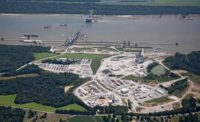Around the world, concerns related to stresses on water systems—availability, quality and impacts from intense storm events—are creating increasing demand for water and wastewater projects.
|
Related Link:
Global Sourcebook PDF |
Water-related opportunities are everywhere, whether it’s meeting the needs of countries installing comprehensive water systems for the first time or those that need major infrastructure investment for growing populations, often in water-scarce regions, says Alan Krause, chairman and CEO of MWH Global.
“So many cities throughout the world are working on systems that are approaching 100 years old, and a great deal of work is being done to modernize those systems,” Krause says.
Water scarcity challenges have spurred greater interest in reusing wastewater, which offers a cost-competitive option for adding new water into systems, says Krause. “Some large urban areas can produce over a billion gallons each day of discharge from municipal facilities. It has been estimated that up to 60% of urban reuse is conceivable,” he observes.
Peter Nicol, global group president for CH2M’s water business, notes that, with many regions running low on cleaner and less challenging water sources, governments are exploring how reuse can be used to meet industrial growth and potable demands for expanding populations. “We’ve seen how Singapore and Australia have used reuse successfully, and now it’s being considered in water-stressed regions such as India and the Middle East,” he says. CH2M currently is finishing a full-scale groundwater replenishment plant in Perth, Australia, that will help to secure the region’s drinking-water supplies through 2060.
The Gulf Arab states continue to provide ample opportunities. A number of desalination plants and major wastewater infrastructure projects are in the works, says Dave LeCureux, director of HDR’s global water practice. “Water supply, wastewater collection and water quality play key roles in this region, and leaders are now considering the impacts from development on the overall health of the Gulf, including increasing groundwater infiltration,” he says.
Water and wastewater system resiliency is another major issue facing communities worldwide, LeCureux says. “Our clients are concerned with how to protect their critical infrastructure in … case of large-scale flooding or hurricanes. The goal is to construct facilities in such a way that systems can come back on line as soon as possible after a large event,” he says. In some cases, systems are being designed as floodable but recoverable afterward, Nicol says. “Now, we’re seeing this new type of resiliency where, instead of building a higher wall, the infrastructure is modeled to work with some of the events that you know you’re going to face,” Nicol says. “It’s a function of managing for that outcome, instead of protecting against it.” In London, CH2M is the delivery partner on the 10-year Thames Estuary Asset Management 2100 Programme to refurbish and replace tidal flood defenses in London and the Thames estuary. The program, which will protect £200 billion of property along the Thames, is currently one of the largest flood risk-management projects in the world.
Leslie Shoemaker, Tetra Tech’s executive vice president of water, environment and infrastructure, says smart and integrated water-management approaches that combine new and emerging technologies to better monitor, track and optimize systems are an emerging driver in developed markets. Along these same lines, Shoemaker sees increasing interest in the development of flexible water and wastewater management systems that can function efficiently in long cyclical droughts but quickly adapt to extreme wet conditions, when flooding risks are elevated. “Flexible water management goes right back to the idea of using real-time control and smart water technology.”




Post a comment to this article
Report Abusive Comment